Theo Verelst Local Diary Page 35
I've ditched the usual header for the
moment, I think it doesn't help much anyhow.
This page is copyrighted by me, and may be read and transfered by any
means only as a whole and including the references to me. I
guess thats normal.
Wed Aug 16 20:36, 2006
Thats when I started the html of this page, I've made
images, and like if my .org would be on the stock market I have to make
clear to the stockholders that its intrinsic value is steadily on the
increase (or staying at a high level...) so lets see if I can double
the stakes (subjects) again this time...
Kidding of course, I don't even have a company (let alone money...) and
I don't believe .org s should be on the stock market. Another
joke from a recent (for me) fortune:
All science is either physics or stamp
collecting.
-- Ernest Rutherford
That's the scientist who invented the early 20th century atom model,
before quantum mechanics shattered it...
Well, I got some good stamps here, and I AM really a very good
physicist, and have grades and work to prove it, so maybe I'll do
something in that line here.
The finishing of this page is now done a lot later, so various texts
are from later date, now it is Nov 25... Don't forget to check out the next diary page,
too that's a pretty cool one.
A Nasa top lunch joke
Well, one can be without income, without public status
maybe, and society can be so rotten a well educated engineer
doesn´t even want to work in many jobs anymore, but they can't
take a man's dreams away.
So lets dream of having time and space to have lunch with
important people of Nasa, maybe Neil would be around, so lets say today
I´d have lunch with oKeefe or the current
head-administrator mc Griffin (both Irish ancestors,
thinking about the "Bonfire Of Vanities" descriptions ?). So I´d
play the ball of wanting to be on a Jupiter mission as
astrounaut/scientiest or so, an dof course I´d have to tell a
good story or a good joke. I read one in a dutch (Jewish) joke book:
You know this one about the guy visiting the Kremlin?
This guy runs into a russion party head who talks to him and says "You
know we have a big publicity problem here, I think we're being called
anti-semitic". No no, the guy says, that´s not so, don't worry,
that was in the time of Stalin, maybe during the cold war, but not
now... Well, the party head counters, I think it is really opportune to
send a good will signal so lets do something nice for the jews here,
lets see, maybe you organize a jewish worship service here in Moscow,
you know, give them a nice place. The guy leaves, and returns again
later a bit upset, " Well, how did it go, you found some good rabbi to
lead the service?". The guy shakes his head: "there are a lot of rabbis
around". Surprised the party head asks what the problem was: "There're
all jewish..."
Quality pictures howto ?
The last say 3/4th of a decade I´ve on and off be dealing with
relatively high quality photographs and artwork, Before that, I made
some pictures as a kid an teenager, some black and white, some color
holiday pictures, and more recently I did a (up to good standard' video
course while I worked at university, and used the university music
centre video recording and editing equipment to do nice super VHS video
work, for instance I taped all kinds of works at the 1991 or '92
Dokumenta (World famous art exhibition in Kassel, Germany) recorded a
(amature) stage play, things like that.
The quality of the picture below is fairly good, the original is 5 Mega
Pixel (25xx X 18xx or so)
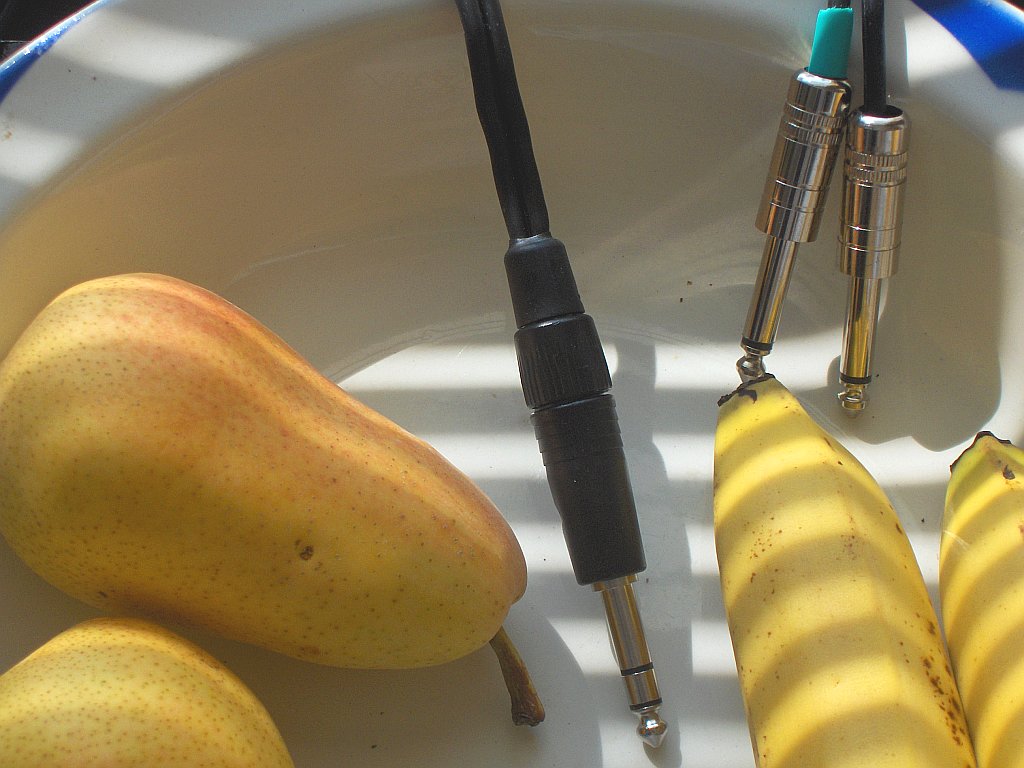
Of course how that comes across to you depends on the quality and
picture reproduction characteristics of you monitor or your printout,
likethe size, the darkness or lightness and natural color saturation
and gamma curve of your viewer, and the influence of the browser on
that.
I find the folowing pictures from a 70s book very pleasing even though
there are clearly issues with the color, I guess its a matter of how
the sun shone, too:

great.
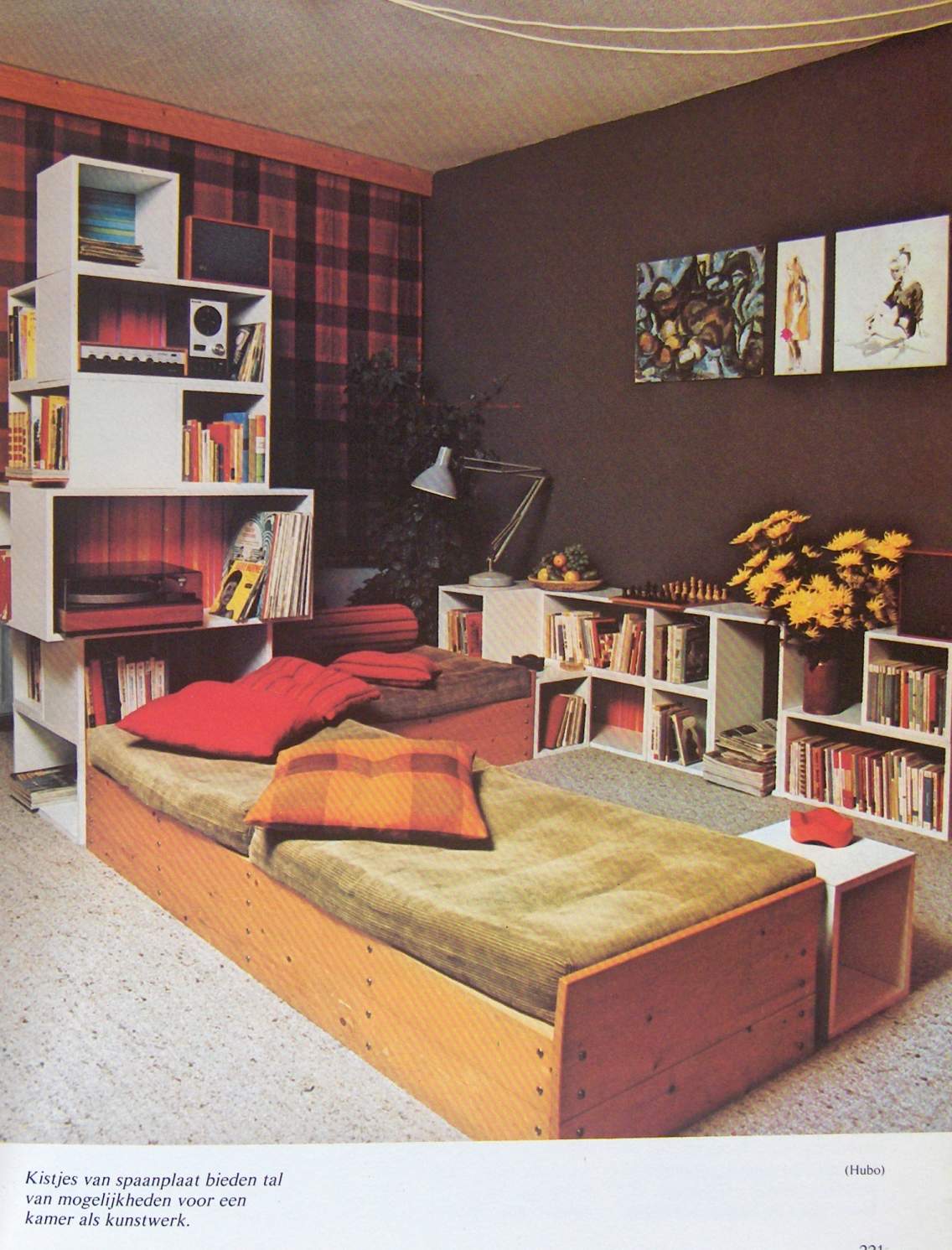
What a space and rest, and interest of colours and playfullness, so
incomparable with the new age we're living in, so infinitely superior.
The next one is a bit dorky I agree but pretty too:

Oh I scanned these pictures from here, I hope that's ok:
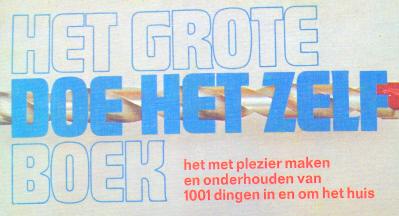
I found it somewhere by chance.
Below I screendumped a frame from a HD movie experiment I filmed at
dusk, so with just enough light to make a picture, and noise in it. I
ffmpeg-ed the movie to 720p format, and looked at the noise and motion
after transcoding it from mpeg2 transport format to Quicktime for Linux
mp4, and then back to mp2 to view it with a purevideo hardware
accelerated viewer to get no glitches, delays or any artifacts even at
very high resolution (720p or 1080i).

The motion interpolation going on in mp4 makes the motion nicer, and
even at low bandwidth (such as above) its still possible to get a high
resolution feel, especially with moving picture, which looks better
than stills.
In the next picture I've used Gimp image processing to give sky another
look, for just one frame:
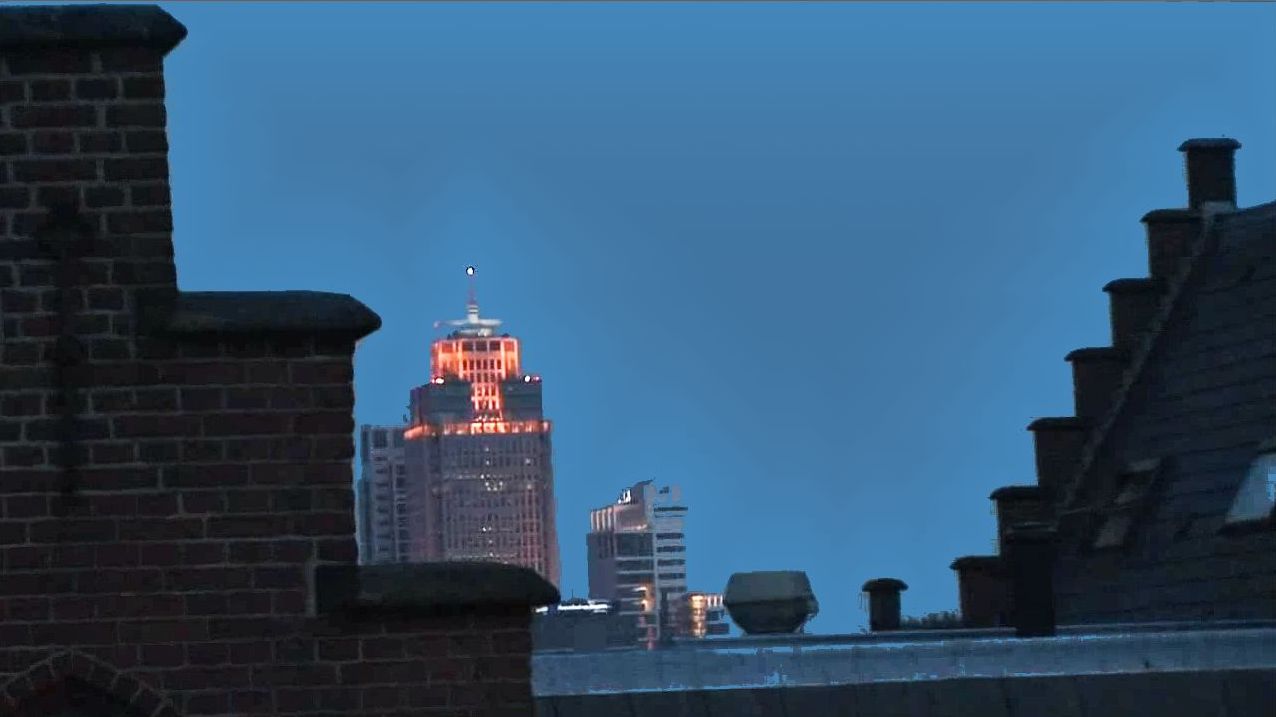
that would be better, but on the other hand its very unnatural, I
really like the noisyness too, when it's real noise.
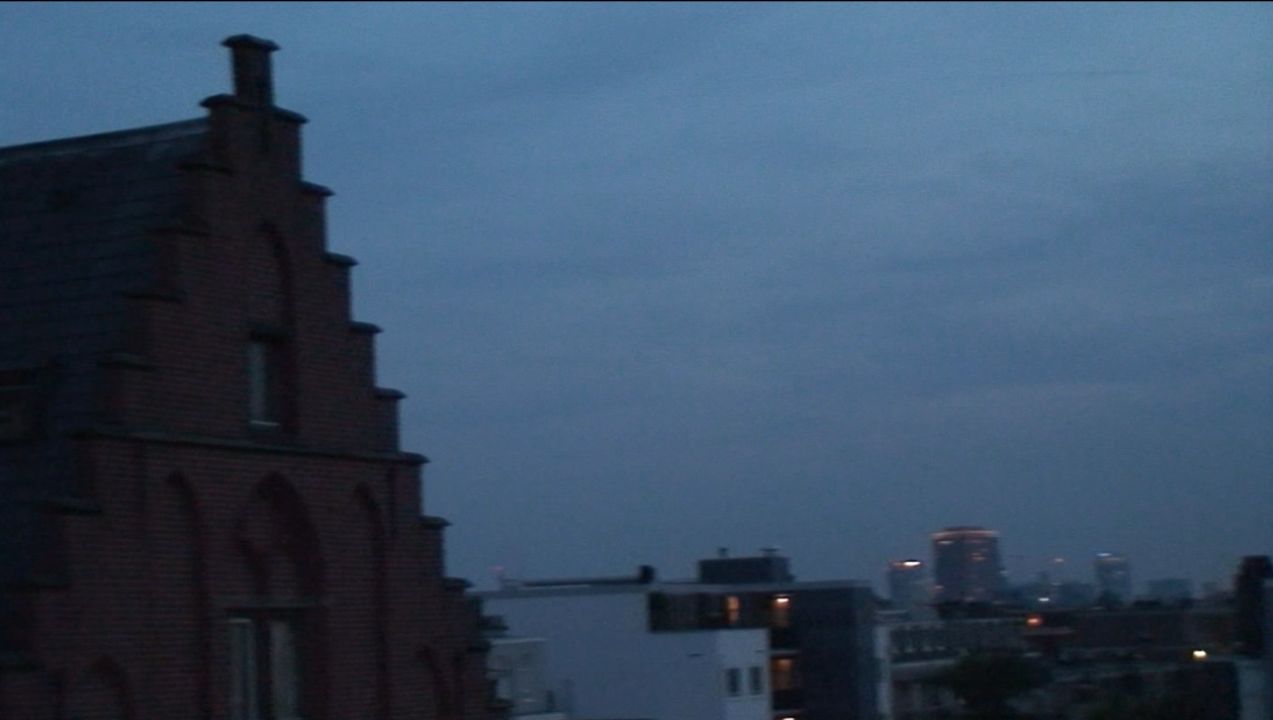
(click image for original HD version, which is jpeg compress of course)
The above image is made from a moving camera (a pan from right to left)
of course there is fuzzyness on mainly the side edges. Depending on
light and diafragm setting and lens size and film sensitivity and of
course the speed of the motion, that is normal and called motion blur. Only with enough light
and small shutter (exposure) times compared with the frame rate,
stills would look like pictures without fuzziness. During playback,
this is important also to make motion look natural, either for film
(shutter time based) television (electron beam travel across the screen
based) or mpeg or other LCD/TFT screen update regime based (per screen
or row or column, with varying response time).
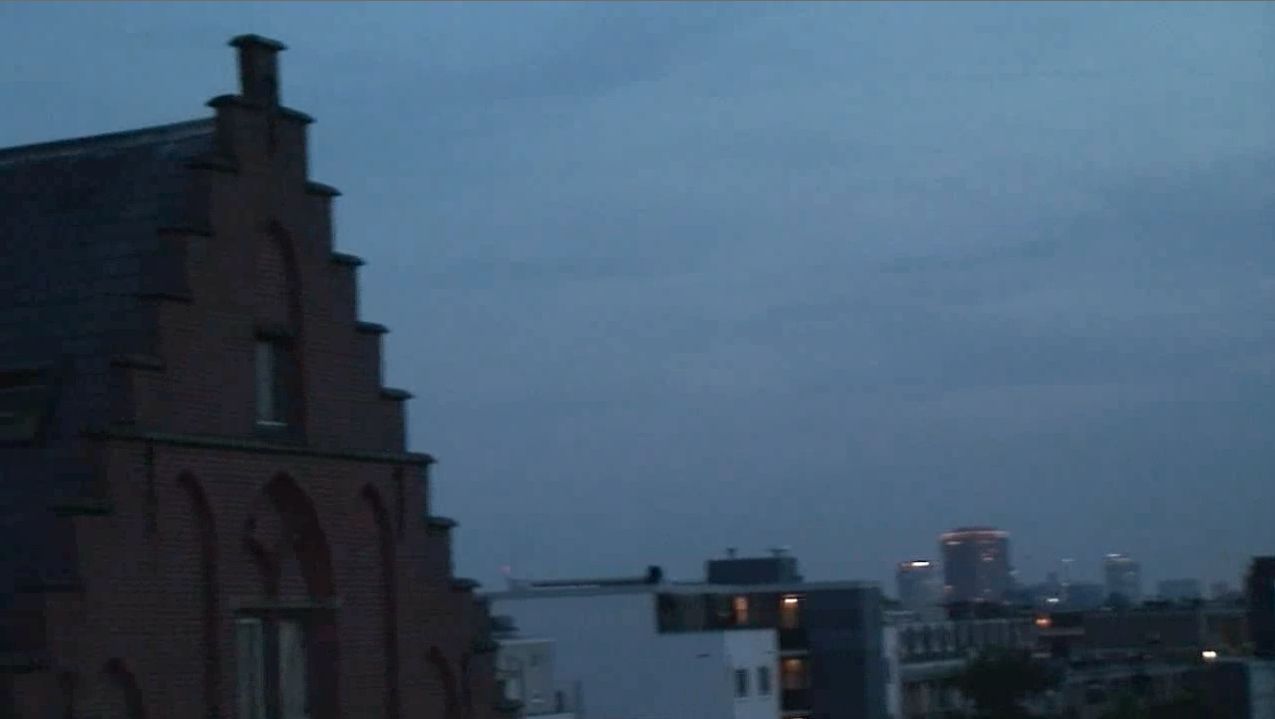
With practice or education (I suppose) one can see wether a still has
natural or artificial noise and motion blur effects, and I happen most
of the time to like it to transcode material over mp4 which improves
the motion effects. I'm aware of the limitation that 3D motion can be
messed up a bit when interpolation is done, so it' s just a general
idea, not in every way correct. Just like a motion stabelizer in a
camera r in software cannot predict the parts coming up in the next
frame which were previously hidden.

This is from the HDnet 720 HD film which is downloadable from the
internet about the return to flight space shuttle flight from 2005. A
lot of different feels are present in the movie, the 70's like not
unsubtly enhanced look is what I prefer by fat the most.
Below another scene from that movie, on an actual screen dump from a
big screen, which is great to work with, together with a gelato 3D
graphics rendering of the famous teapot with an environment picture
mapped onto it from a picture I made and nice glossyness.
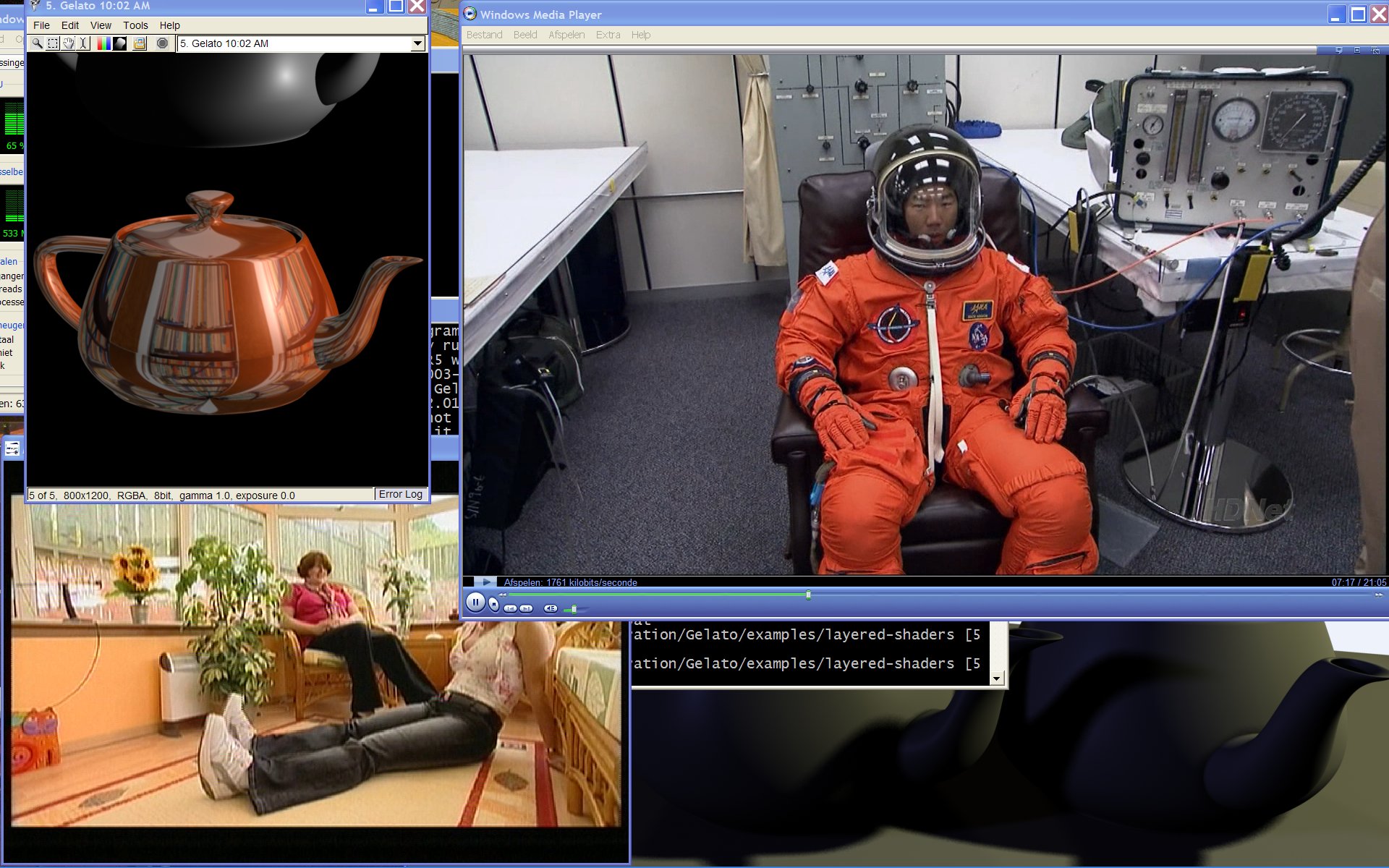
Gelato is a movie rendering quality set of programs/libraries for
curved surface, complex lighting scenes which makes use of NVidia
graphics cards with up to date engines (at least 6200, but that isn't
perfect), preferably a Quadro card. In right bottom corner another
gelato rendering (which is uncomparably faster than for instance
POVray, and not similar) with smooth shadows in it.
On the the BBC widescreen I suppose 576p there was a program which I
watch primarily because of the HD-ish pictures from good cameras with
houses an interiors and countryscapes in it, which is nice to watch
from digital satelite.

A recent playlist, good for conservatory use...
Filters ?!?
Well, that's different from coffefilters for electronicists. This is a
screendump from Qucs, which is a relatively new circuit simulator from
europe (I'm sure the origins lie elsewhere) which allows one to relive
some potent and good network theory basics (I'm a network theory (EE)
master of science by eduction, but is is first year stuff) for instance
this first order filter circuit, of course analog, not digital:
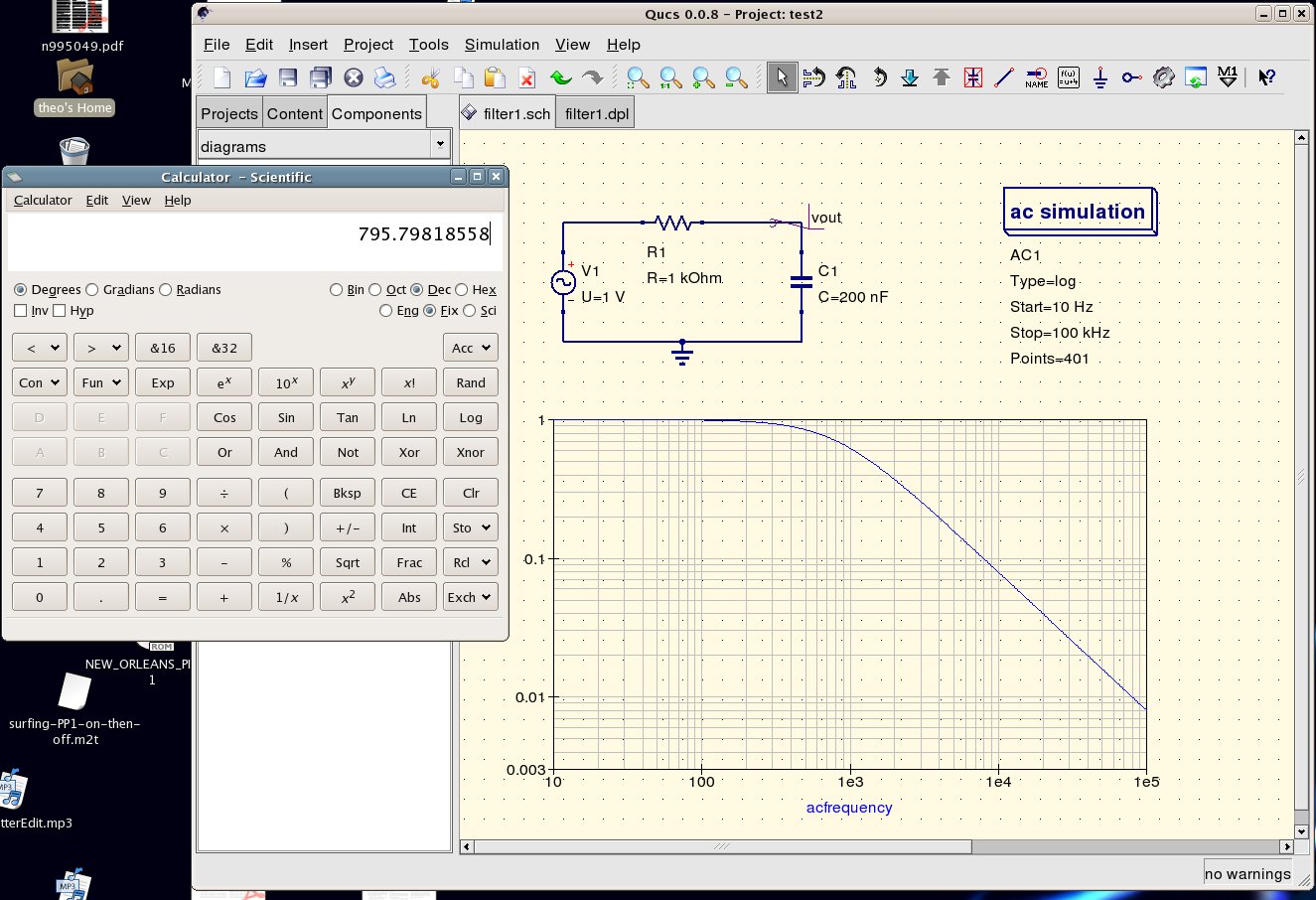
The calculator shows the cutoff frequency for the filter circuit
according to the 1/(2 x pi x R x C) formula, the graph shows a
simulation of the circuit which rendered a frequency vs amplitude plot,
which indeed shows that cutoff frequency, and the expected low pass
response.
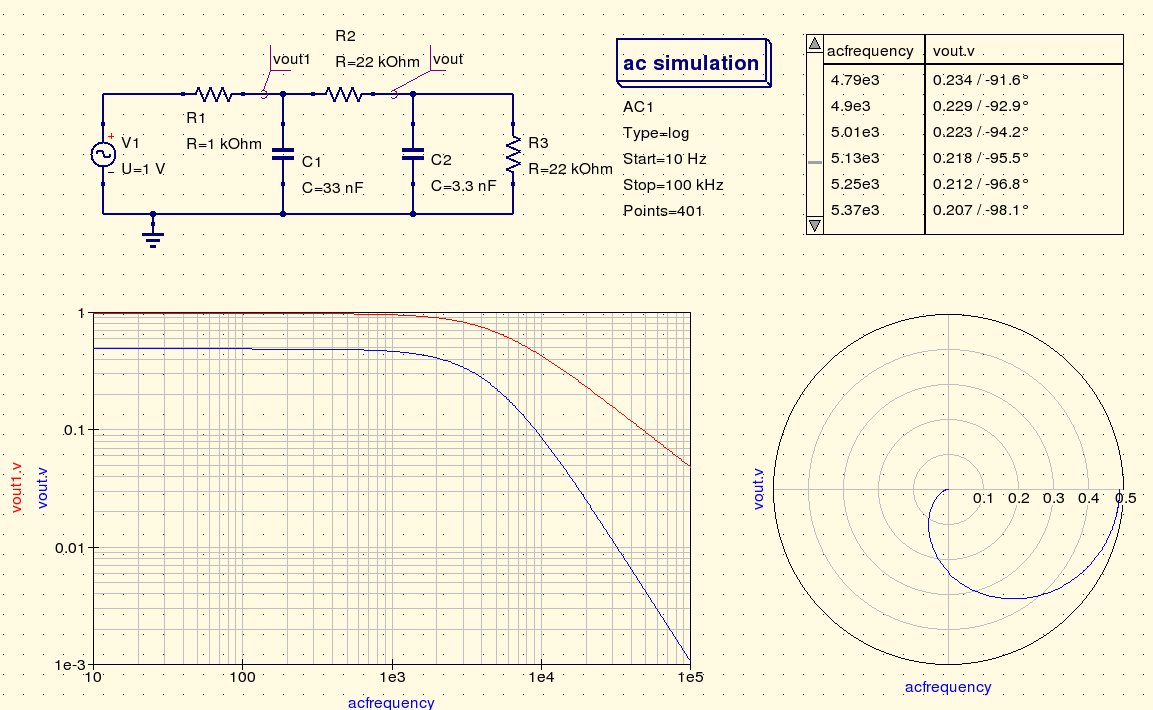
This image shows the simulation of a second order filter I designed
using an approach from the past (I did this already back in the end of
the 70s), which actually in implementation lives in the powered
bi-amped monitors I made last year. As can be seen from the vout and
vout pins' response, the cutoff frequency, which is in practice a
takeover frequency because there is a complementary circuit for the
tweeter amplifiers, is 5 kHz. Taking into acount the 0.5 damping
through the filter and its resistive load of 22kOhm this is a cascade
of two first order filter responses which is 0.25 at the -3dB point
(-3dB + -3dB + -6dB = -12 dB --> 1/4).
This filter, in analog form as above has been appied to my powered
monitor biamplifier chain which can be seen in the Freely reusable
schematics below. Using a Very high quality opamp stage as preamplifier
the overall quality and behaviour of the circuit is excellent and very
natural, and also an extra AD/DA stage is prevented, including anti
aliasing filter and reconstruction filter are alleviated which is very
good for unsampled sources or very high quality DA converter outputs
being fed into the monitors.
Those opamps are recent high quality audio opamps of BurrBrown / Texas
Instruments, which are quite expensive in comparison with run of the
mill audio amp chips, but very good numerically and in listening tests
it also performs very neutral and beautifully, I had some samples form
TI through which I knew this, and I was able to order directly from
Newark InOne (New Jersey, USA).
Better Sound Through Research
Thats a Slogan from Bose (Research) and it applied to probably most or
all of the good audio things from the organs in the middle ages and
greek string theory to the latest synthesizers and theater sound
systems.
Research in that sense doesn't mean checking out associations, wether
mother or mr so and so is felt in the system or work, but of course
there is more to music and musical processing than dry scientific
analysis and probably certain issues are subjective and relative to
cultural assumptions, though most of the good work I'd say is hardly
cultural except for its history. Meaning that there are various clear
sources who worked on music, like the old classical composers and
performers, the various people working on the new musical styles and
the number of pioneers who made modern music possible.
I of course don't mean the up the attic boys with samples and a great
idea about scratch patterns, that's ridiculous, but people like Chuck
Berry, Robert Johnson, Irving Berlin, mainly american dance orchestras
from the 20s through the 60s, Bill Haley, Bob Moog, Laurens Hammond,
Goodman, J. Hendrix, the Commodores, and many many others. I'm talking
about the top, the pioneers who were really inventors and musicians of
high standing, not wannabees or takers of other peoples samples
or so!
Of course, music making requires instruments, and making music sound
may require recording or tranmission machinery, which has mainly been
invented in the 20th century.
As another electronics created possibility not just recording and
broadcasting became available but also amplification and electronic
musical instruments of various kinds. On of the most influencial and
far stretching electronical musical instruments apart from organs us
the synthesizer. Below an add from the 60s with a picture of the 'back
room' from the moog synthesizer company.
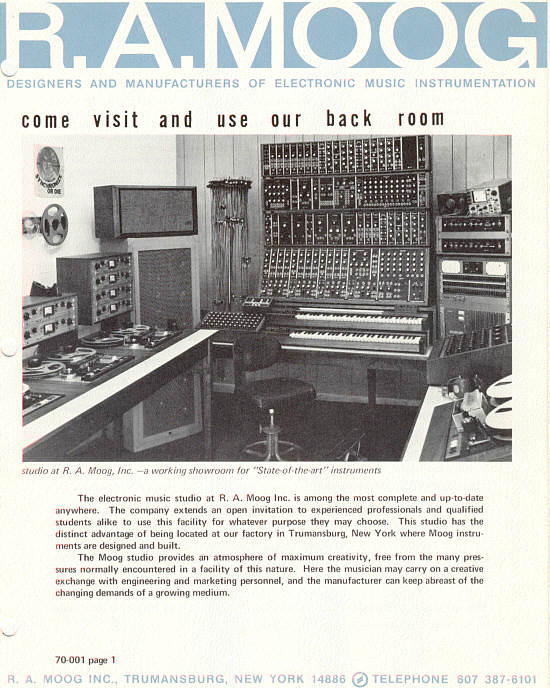
They recorded. apart from numerous hits with the moogs on them, a demo
record which is also available on the internet.
I did a little research or checking if theory known to me works in
practice and wether my self built and used equipment lives up to the
theoretical quality levels. See here a recording from notes from my synthesizer with the
filter all open, and one oscillator working, digitized with a Lexicon
Omega USB AD/DA converter (24bits), which is of very high fidelity:
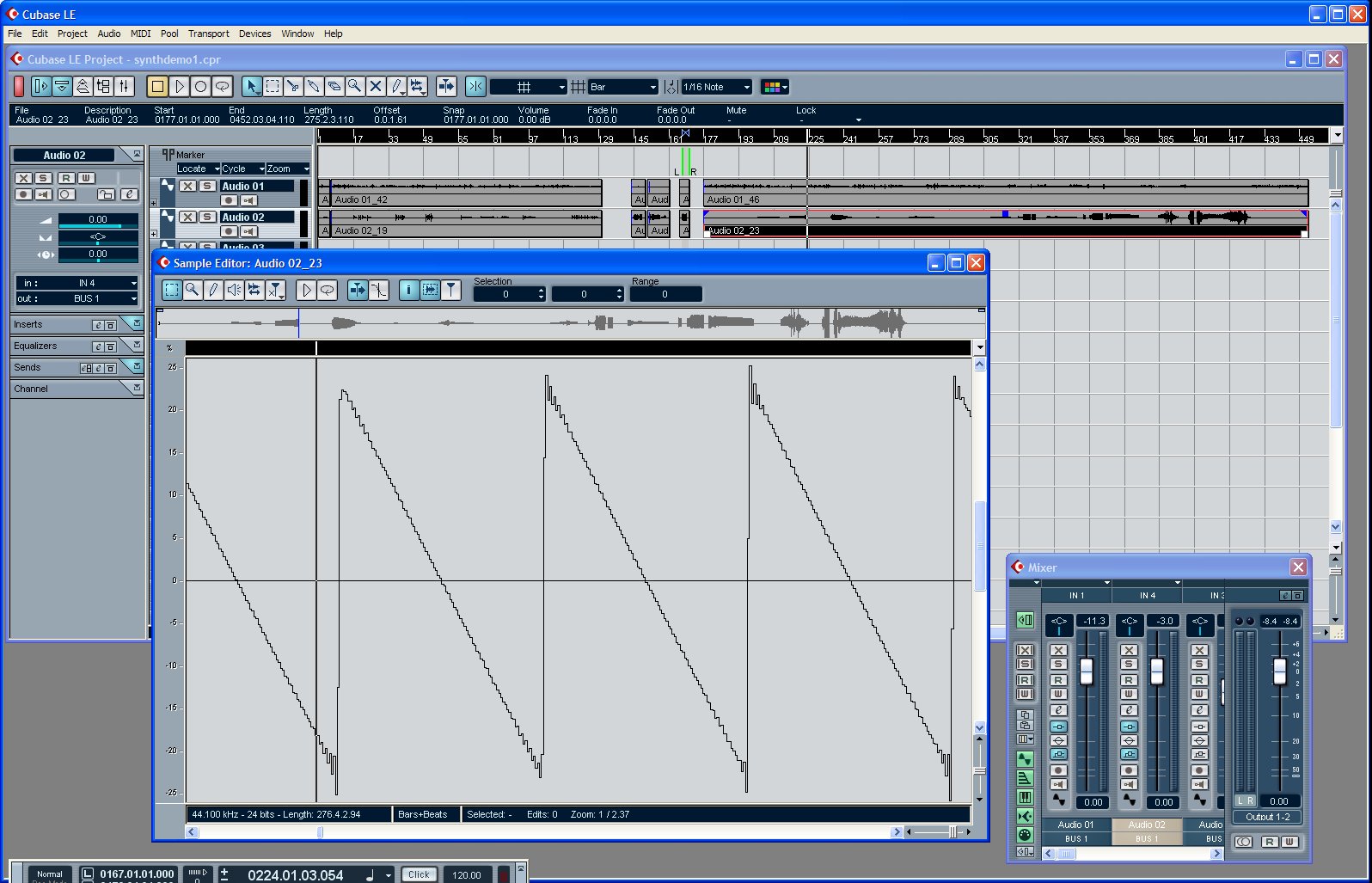
The saftooth waves are all the same, and their highest harmonics, which
are limited to no more than half the sampling rate (the Niquist rate)
become visible as part of the perfect additive synthesis of a frequency
limited sawtooth wave, and are shown to be sampled with sampling points
which are not linked with the clock of the DA converter of the origina
wave. So when the waves are shown with a simple reconstruction
filter o the screen, ik this case a zeroth or first order approximation
(straight lines) there is visible unevenness of the samples, which is
completely correct, according to theory, and can be perfectly
reconstructed!!! Indeed, the outcoming sound is hardly uneven or
distorted, which is not true for just about every software
synthesizer I've heard (and that's a lot of them). A little ' running'
effect in thehigh is there which is logical because of the non-perfect
reconstruction filter, and in the hioghest 1/2 octave there is
noticable foldback (aliasing). Also, it is possible to hear a bit grain
or harmonic distortion in the very high (note that I have some very
serious amplification to hear that) both in the original synthesiuzer
DA conversion and there is a bit muffled of that effect audible also at
the lexicon output, a bit brick wall (good) filtered, and a bit less
brigth (not perfect). Both effects are about sawtooth waves with
harmonic components fully present to the last octave where those are
just under the Niquist frequency...
Half a Bose sticker makes this Ikea stool look more scientific:
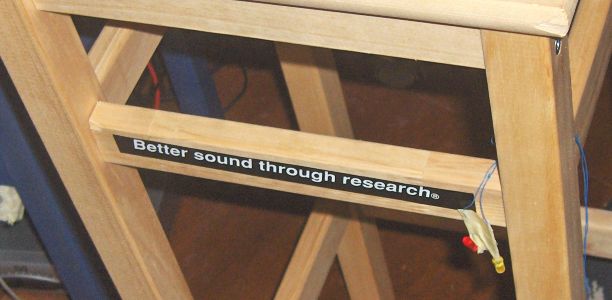
In my highschool time, around '80, I had acces to Hameg Oscilloscopes
to play (seriously and under strict rules..) and work with, and at the
time probably tectronics was a slightly sexier (if possible) brand of
measurement equipment. I saw them at the Ibc in
Amsterdam, and had a
quick cam sweep over the stand, showing a mpeg audio stream analyser,
which is sort of like a digital stream and protocol analyzer:
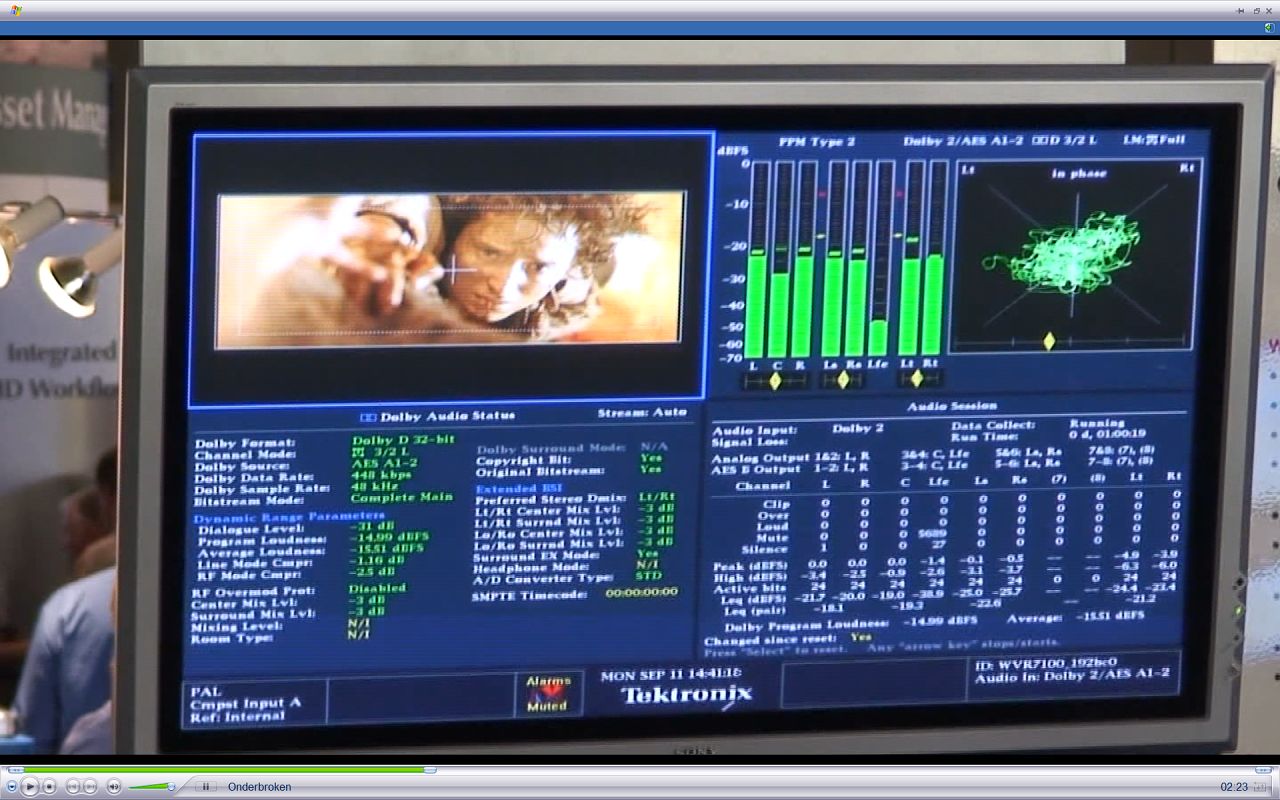
Interesting in the context of measurement, I saw this article in the
conditions of use or license for some microsoft product, I think it was
media encoder or the studio version, which requires the installation of
.net, increasing security riscs, disc use and startup time, and the
product was worthless thus far, can´t even read standard mpeg-2
transport stream, though maybe I´ll be able with it to write
microsoft windows media format HD video files This is the quote (in
dutch):.
3.
Aanvullende rechten en beperkingen.
3.1 De Client
OS-componenten kunnen de Microsoft .NET structuur bevatten. U mag de
resultaten van enige vergelijkende test van het .NET Framework niet aan
derden bekendmaken zonder voorafgaande schriftelijke toestemming van
Microsoft.
One may not publish comparison tests about the .net framework without
prior permission of microsoft.
Tss.
Dolby is actually closed and licensed...
Audio waves
That´s a bit harder than a digital single signal, because audio
waves
pass through a 3 dimensional space, speaking as a physicist.
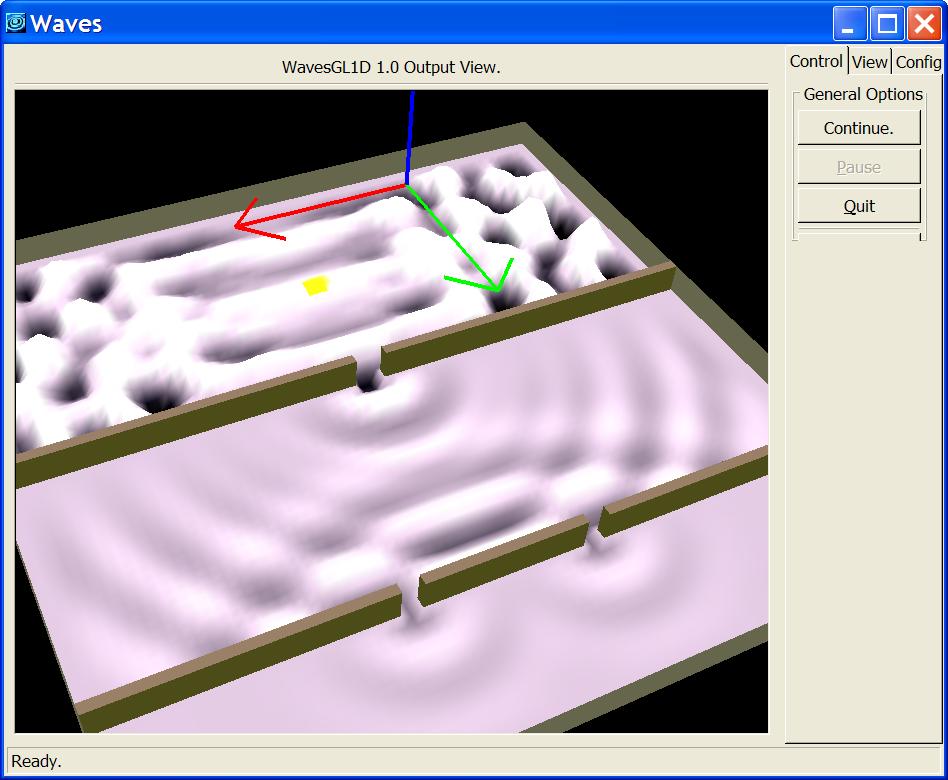
The above is a screen picture program (free from the internet) does the
well known (highschool physics) experiment of a virtual waves in a
virtual tub, the
screen clearly shows the Huygens behaviour for waves emanating
from holes which are small in comparison with the wavelength.
The waves from this electrical circuit were a bit in trouble, I open
the machine,m anmd repqired the wiring from the graphics card
connector, and now its running good again:
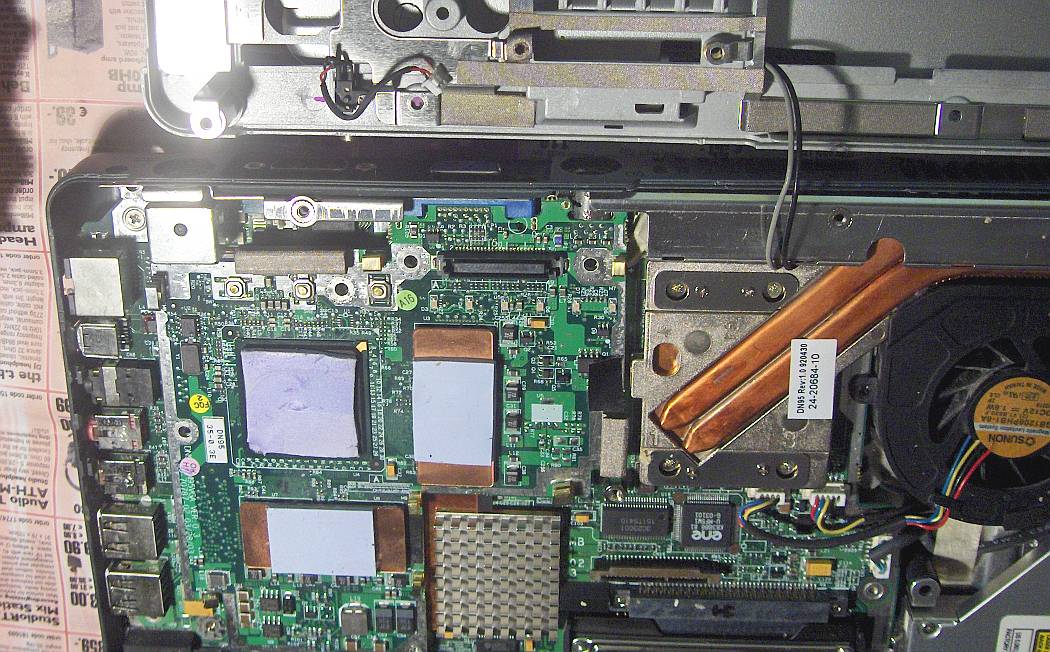
some work, though, and the machine is a bit noisy, but it has run for
years and still runs XP and Linux pretty fast (2.6 GHz pentium), and
the SMART readout doesn't compain that the disc has worn out, even
though I'd have a installed and running replacement. The switched
supply (150Watts...) has had its fan replaced, after it had
autoshutdown when I was working with it in france on my Open Source Additive Synthesis
software. But the machine would run like easily 8 hours a day already
for more than a few years!
Very pleasing (righteous ?) soundwaves came from the Dr. John
performance at the recent North Sea Jazz festival, from the piano, the
bass (and the amp) the drums and the organ and guitar, except the PA
system (those hangning arrays) soudns really harsh, cornerish, hyped
bassy and generally distorted and limited, though luckily all those
things within sime control and the volume not ot of bounds and not too
soft.
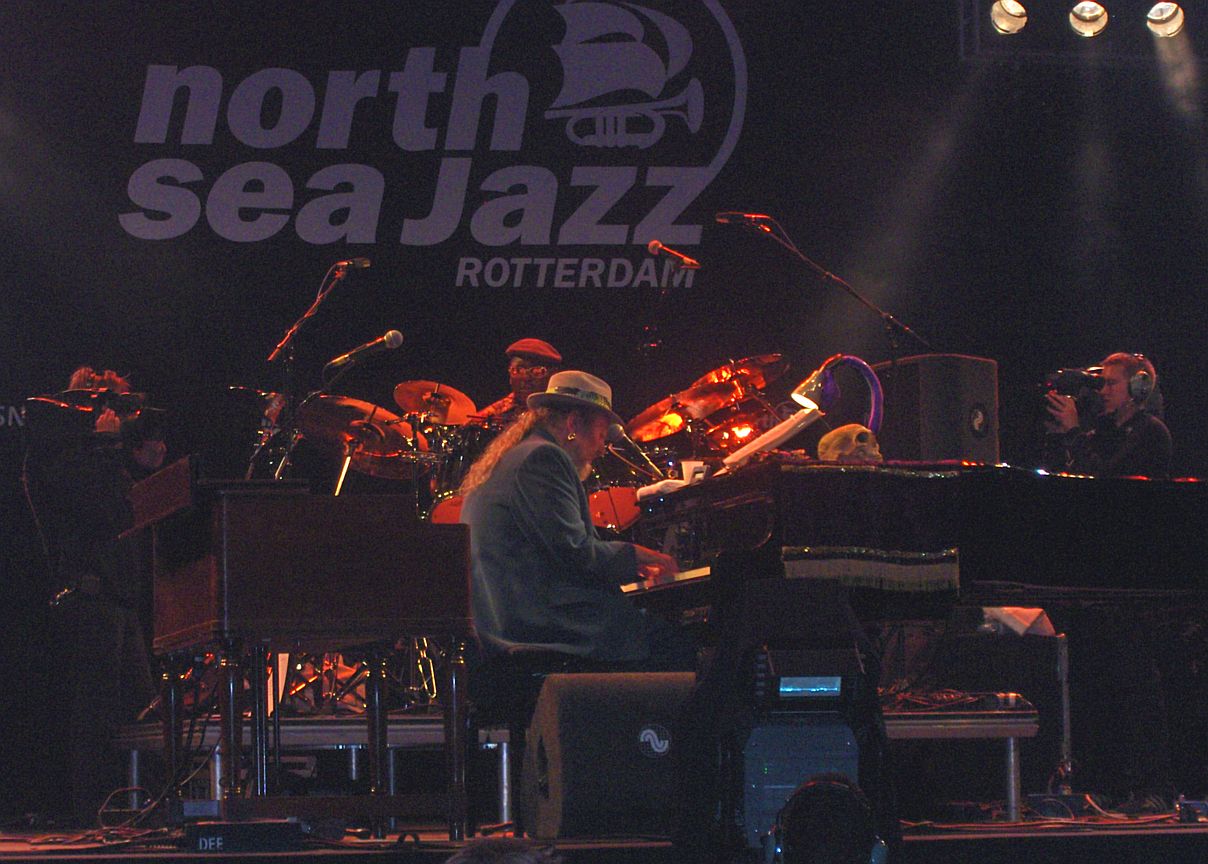
But the heavenly sounds from the instruments (the bass sounded
interesting for instance and very drive-full) were not very done well
be the amping unfortunately, maybe something to change for such a top
event.
Mr John had a skull on a scarf or cloth on the piano which reminds of
the table in the from of the church I was taken to as a kid, and was
very clearly not Dutch.
Thank God.
Open Source Very High Quality Biamped Monitors
I´ve shown them on musical instrument fairs a conference, several
audio related places, taken them to france, used them for all kinds of
things from HD video sound monitoring to playing CD´s on the
waterside, from studio monitoring to guitar and keyboard amplification,
and they perform really good for all the time and sound very natural,
neutral, and strong.
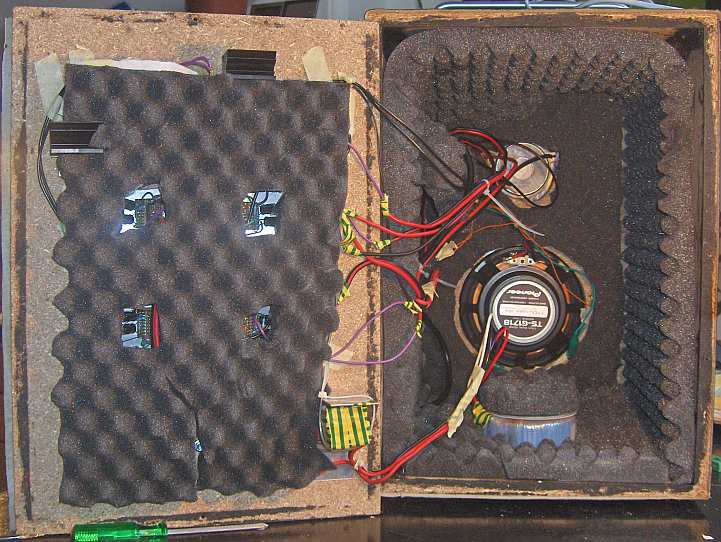
The speaker units are Pioneer and Jvc, the former being a specific
(fairly recent) type of car speaker, which I modified by clipping of
the extra high frequency cone in the middle, and the dome tweeter was
from a series I found in an electronics parts store, a quite powerfull
one, like the woofer has a rated peak power of 175 Watts,which however
probably cannot be produced by the built in amplifiers, but I
didn´t measure this.
They are more made to drive about 40 Watts continuous, the continuous
power rating of the woofers, and that real good, with very low
distortion compared with anything except high rated studio monitors
like Quested or so, and those 4 end amplifiers, which are integrated in
the right speaker are driven by 2d order butterworth type electronic
(cascaded 1st order sections without resonance or active parts, made
with very good capacitors and metalfilm resistors) seperation filters
which are driven by a very high quality pre amplifier.
The aluminium connector panel is on the right side, with a volume
control, a 1/4" stereo jack audio input, an on/off switch and a stereo
jack plug for connecting up the high and low signal for the passive
left side speakerbox. also on the right on the lower back side there is
a flexible and easy to use, slim plug, ungrounded mains cable, which is
loaded by a good quality toroid transformer of 120Watts continuous on
the bottom plate of the powered speaker, weight balanced.
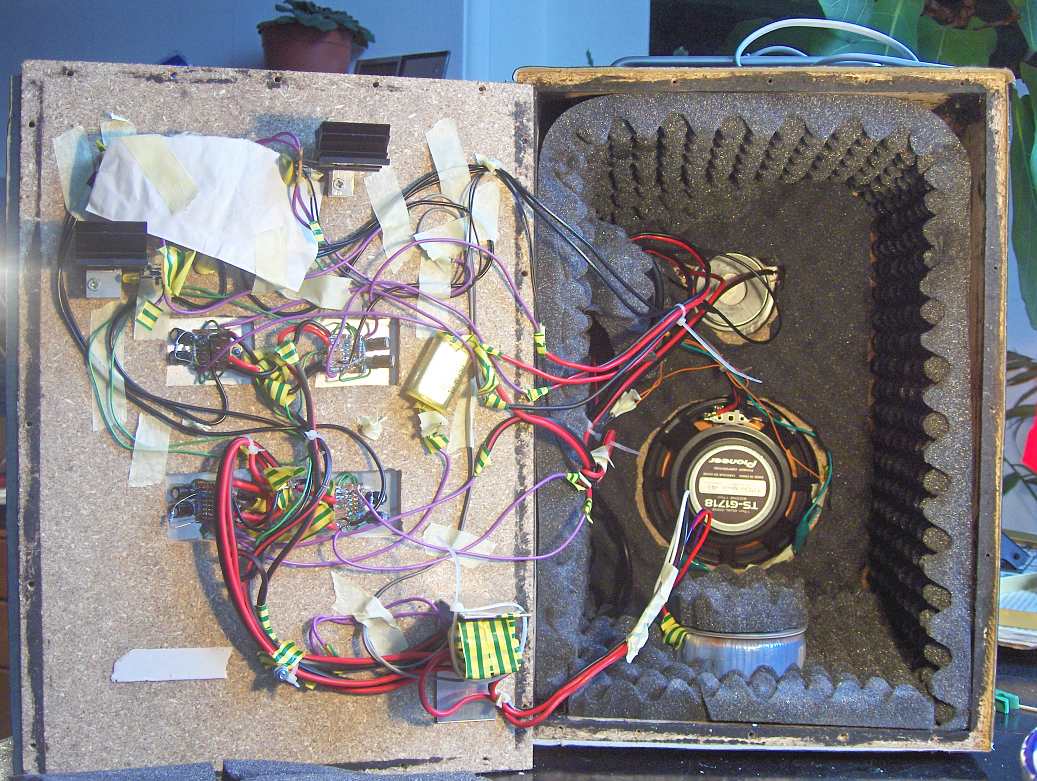
The crossover frequency has been measured and tested (also with a
digital filter) to be best at 5 kHz, see here.
The aluminium (flat) back plate is the cooling plate for the 4 end
amplifiers.
This is the filter prototype circuit board:
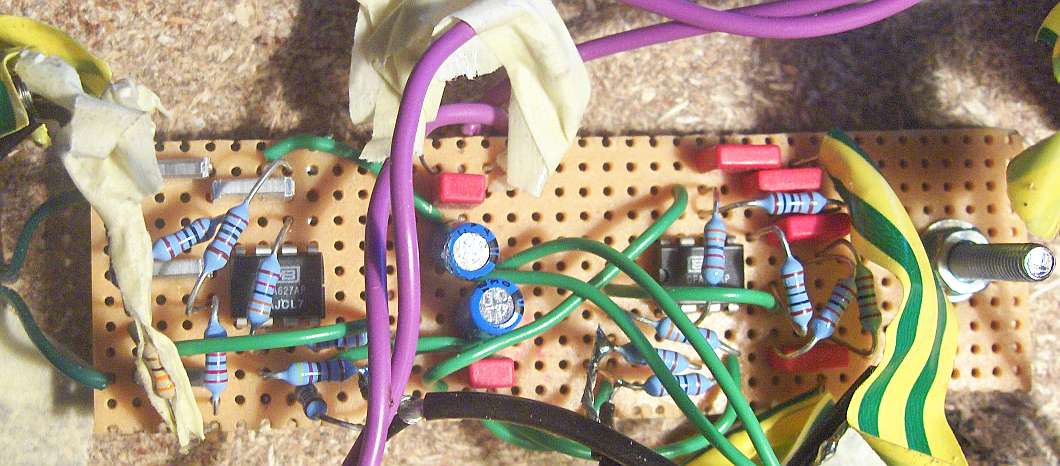
All these circuits are designed and built by me, this is the overall
circuit:

Free to use for non-commercial purposes, email me. Notice that there is
provision for preventing grounding loops, hum and crosstalk by using
the grounding wire network as in the diagram. This is essential, just
like using thick enough supply wires, the circuit is certain to
underperform or even oscillate or not function at all when these
overall network theoretical issues are not dealt with properly in the
implementation.
This is the back of the synthesizer unit in use as main system pre
amplifier, with the neutrix jack as input plug, with on top of it a
Xilinx spartan 3 FPGA with bus connection to a dual core Blackfin DSP
board which in this case runs a reverb with VU meters and surround (4
fold) audio output which I gave a decent toroid tranformer based supply
unit to put aside the supplied switched unit to prevent noise in the
pretty good 20/24 bit AD/DA converters of the reverb when connecting up
with computer and synthesizer audio signals.
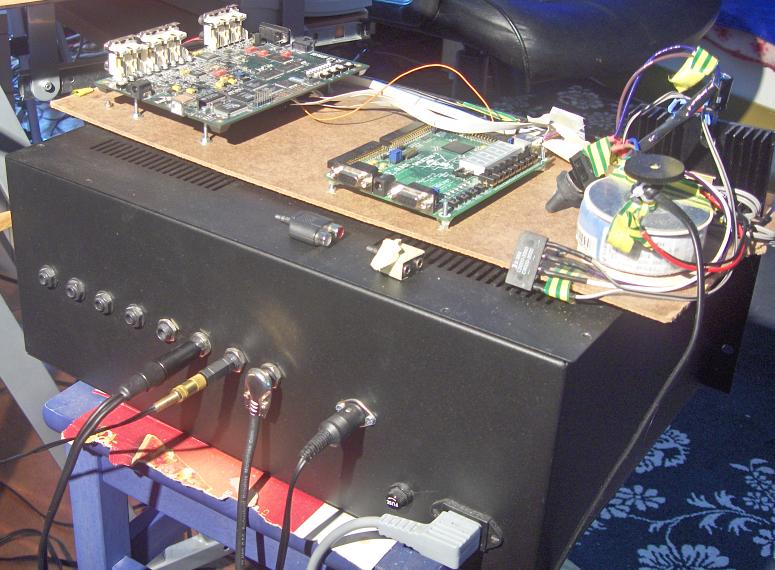
Thus far I like the neutrix jack connector plugs as the only ones to
work real good, both to solder (I have used the new leadless solder
already, but for this job I used the well working standard leaded roll)
and to use, but of course they are a bit expensive.
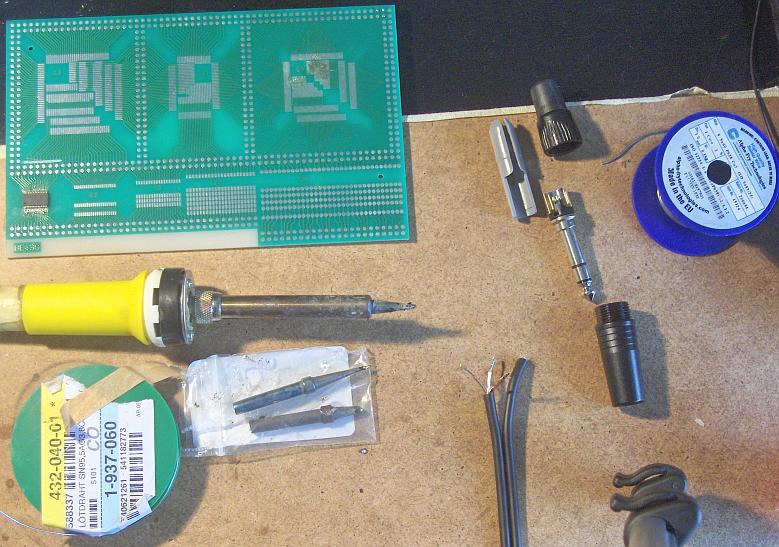
On the bottom left of the circuit board I soldered a TI microphone
preampifier with very high quality digital gain control which I will
like to prototype with. The lead is being soldered to have two
seperately shielded channels, connected together at one point, and a
one side connected overall shield, so that the ground runs trough
seperate inside wires per channel.
I´ve also made a cable to connect a switched supply synthesizer
to a balanced input where the outputs of the synt are not balances but
have the negative line connected to ground of the plug at the connected
machine.
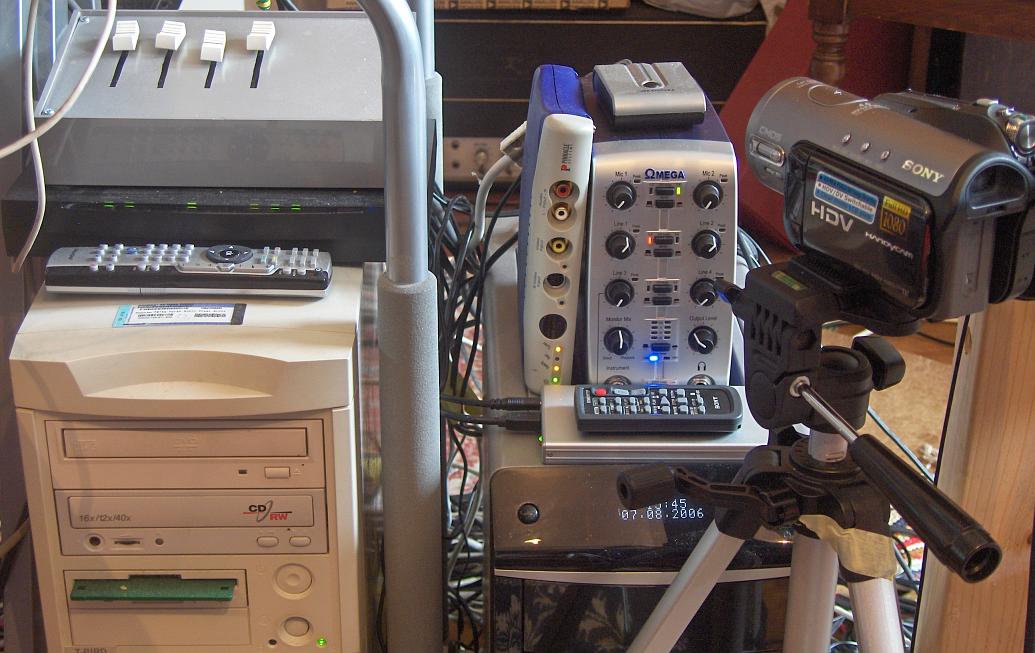
I´m lucky to use (not own) this setup to make recordings of high
quality with, both audio and High Definition video, which is 1080(i).
I´m using the most sold american microphones of the moment for
audio recordings with the USB 4 input / 2 output 24 bit Lexicon box,
which has very good microphone pre-amplifiers (with phantom voltage)
built in, and a Sony very small HD camera which gives very pretty
imagery when used right.
To make this work at all, the audio just requires a computer of any
kind, but to use the Cubase LE program which comes with the lexicon,
and th effects on a complex set of audio tracks requires computer
power, and a lot worse with the HD video: at the moment there is
probably no computer system apart possibly from high end unix systems
or clusters, which can play that content with the standard players.
Well, a fast computer, like a pentium dual core with good motherboard I
tried it on can probably play a 25 MegaBit/S HD stream to some extend
even looking OK, but when deinterlacing or scaling is in order faults
can be seen, and it is very likely that fast scene changes will cause
trouble and at least artifacts can be seen like fast transient line
patterns at block boundaries.
There is a solution though which I use to perfectly view the 1080 x1920
moving images at full 50 frames per second (interlaced) material with
position estimated deinterlacing, and even noise filtereing and very
good
scaling operations, and that is based on acceleration by a potent video
card, I used NVidia Purevideo for the purpose.
I´m not talking about setting a player to ´overlay
mode´ as of course also causes some things to be processed in the
graphics card hardware, thus loading the cpu less, but I´m
talking about a specialized fast processor built in certain graphics
cards which are able to decode mpeg2 (and other) video streams in real
time and in high quality because they are sufficiently powerfull for
that. NVidia offers access to their hardware mpeg decoder by use of the
windows media player when it is unlocked by buying a driver from them,
which cost only $20 and can be ordered over the internet from the US.
Brilliant investment when you have a potent enough nvidia card and a
big enough monitor or screen and interest in HD video.
It is thus far the only way I know, except for a direct connection over
DVI with the camera to get high quality always stable and up to
standard HD content viewing on a computer, and I´ve tried a
Athlon 3.3GHz/64, a Dual core centrino (T2400, 1.83GHz), with a NVidia
6200 card or (much) better, with media player or quicktime player, or
powercinema or Nero player. In fact, if you compile a recent mplayer
(on windows I´ve done that with cygwin), but on linux even
better, you can play these streams pretty well, though by far not as
crispy neat and well-deinterlaced .and motion-straight as with
PureVideo. On Linux, I´ve tried recent Knoppix,
´Live´ and Redhat Fedora Core 4/64 and Core 5 (dual core),
where various players are available, some work a bit for HD, In fact
I´ve gotten Cinerella to Display 24 (full) frames per second on
the fastest machines, which is really cool. Probably a well compiled
(use a ramdisk for temp!) mplayer on Fedora also works ok enough
to use, but still not in the same league as purevideo.
The pinnacle box above is connected to the Linux server where it can be
used with dune to get live and recorded tv of pretty good quality, with
hardware mpeg encoding. The slim unit on the computer is a 60 GB usb
disc which works good on linux or windows.
To get good audio listening experience, standard sound cards are out.
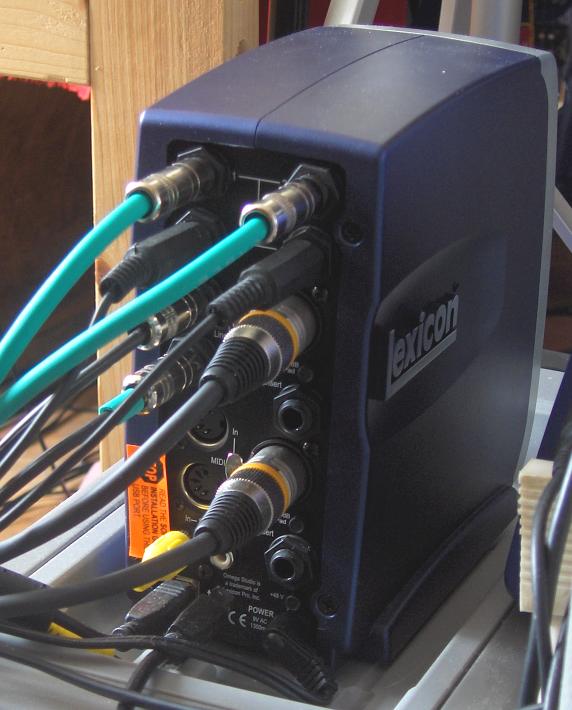
Audio Compressor use, analysis and repair
This is a picture of a pretty desirable analog (!) machine: a Valley
People gainbrain II compressor:

This one was broken, and I fixed itto be used in a studio again.
I was able to find the schematic diagram of this 80s machine on the
internet, which is quite complicated, but I tried to follow it. After a
number of days of finding out various parts of the circuit seemed to
measure to work good I did some opamp measuring and finally had to
conclude on of the TL072 opamps was broken, and indeed it worked good
again after replacing it.
f

























